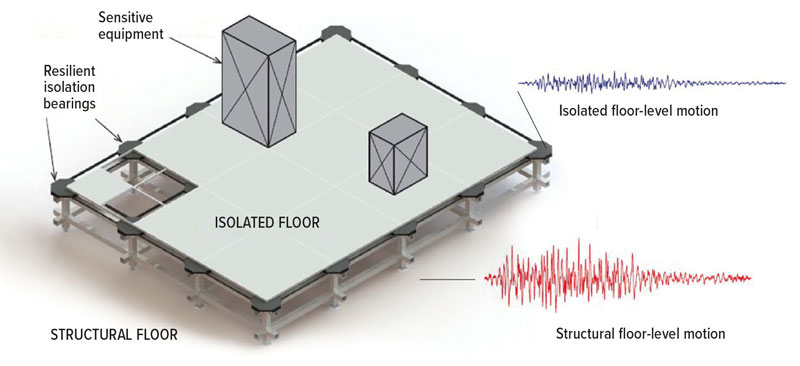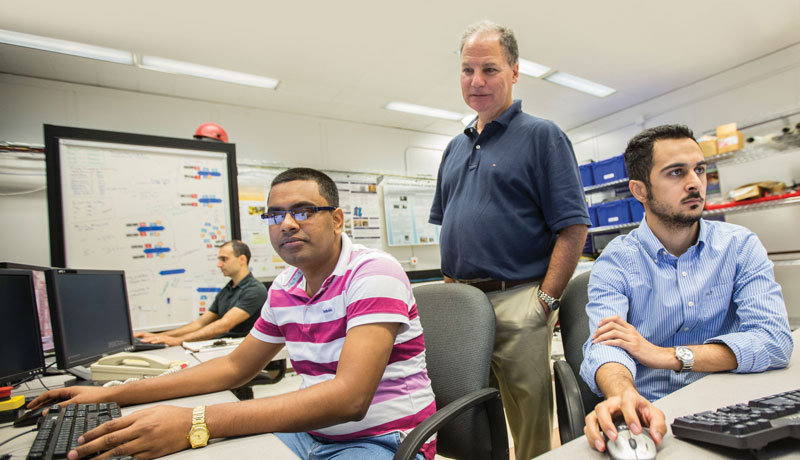By Amanda Allekotte
Equipping buildings in earthquake-prone areas with floor-isolation systems (FISs) could protect the people and property housed inside—and help ensure a quicker, less costly recovery.
The systems, which decouple the motion of the floor from the response of objects during an earthquake, would enhance the resilience of essential facilities, such as hospitals or power plants, by protecting sensitive, critical equipment, says P. Scott Harvey, an associate professor of civil engineering and environmental science at the University of Oklahoma. “By reducing or eliminating downtime in the wake of an earthquake, FISs are a promising retrofit strategy for protecting vital building contents.”
|
Tests conducted at Lehigh will help quantify the performance and limitations of FISs as a strategy to improve earthquake resilience. |
Harvey’s research on FISs has relied on data from shake-table tests, a widely used experimental tool for evaluating the seismic performance of structures. However, “these tests have been limited by payload and dimension capacities of our facilities” and cannot incorporate interactions between a building and a FIS system, he explains.
To overcome those hurdles, Harvey and a graduate student spent five weeks during 2020 on a fellowship at Lehigh’s Natural Hazards Engineering Research Infrastructure (NHERI) Experimental Facility (EF), taking advantage of its state-of-the-art real-time hybrid simulation capabilities.
The NHERI Lehigh EF was created in 2016 with major support from the National Science Foundation as part of a national initiative aimed at improving the resiliency and sustainability of civil infrastructure to better withstand the effects of earthquakes and other natural hazards. It was preceded by Lehigh’s Network for Earthquake Engineering Simulation (NEES) Real-Time Multi-Directional (RTMD) facility.
Since its inception, the NHERI Lehigh EF has operated as a world-class, open-access facility within the Lehigh’s Advanced Technology for Large Structural Systems (ATLSS) Engineering Research Center, now under the umbrella of Lehigh’s Institute for Cyber Physical Infrastructure and Energy (I-CPIE). Over the past five years, it has welcomed researchers from across the country addressing diverse structural engineering research topics associated with the challenge of community resilience.
|
Since 2016, the NHERI Lehigh EF has provided graduate students, such as those advised by Ricles (center), opportunities to gain experience in RTHS techniques. |
In January 2021, the NSF awarded Lehigh a $5.3 million grant renewing the facility for another five years under the continued leadership of James Ricles and Richard Sause. (Ricles is Bruce G. Johnston Professor of Structural Engineering and director of Lehigh’s RTMD Earthquake Simulation Facility; Sause is Joseph T. Stuart Professor of Structural Engineering and director of I-CPIE.) The funding ensures that researchers like Harvey will have access to the facility’s unique experimental resources and data management for NSF-supported research and education awards.
“Leading in the development, implementation, and use of real-time hybrid simulation for large-scale laboratory testing, the facility offers researchers unique advanced testing algorithms that utilize the portfolio of resources,” says Ricles. “The research performed here will increase our knowledge of the physical response characteristics, vulnerabilities, and factors that influence the resiliency of the civil infrastructure.”
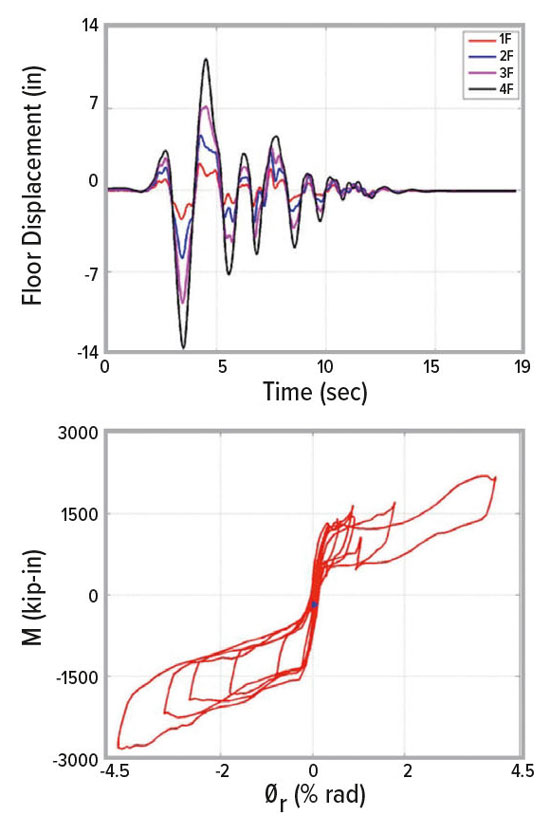 The facility also supports I-CPIE’s commitment to fostering interdisciplinary research within and beyond Lehigh’s campuses. “Large structural systems of the infrastructure are a key research thrust within I-CPIE,” notes Sause. “The NHERI Lehigh EF provides researchers, both internal and external to Lehigh, with a world-class facility focused on mitigating the impacts of earthquake and wind hazards on these structural systems.”
The facility also supports I-CPIE’s commitment to fostering interdisciplinary research within and beyond Lehigh’s campuses. “Large structural systems of the infrastructure are a key research thrust within I-CPIE,” notes Sause. “The NHERI Lehigh EF provides researchers, both internal and external to Lehigh, with a world-class facility focused on mitigating the impacts of earthquake and wind hazards on these structural systems.”
Over the years, Chad Kusko, operations manager for the NHERI Lehigh EF and director of operations for I-CPIE, has helped to organize workshops focused on bringing researchers to tour the facility and become more familiar with its capabilities. The most recent on-campus two-day workshop was held in September 2019 (in conjunction with the NHERI facility at UC San Diego and the NHERI SimCenter at UC Berkeley) and drew almost 40 participants, with the goal of generating new NSF proposals. The event also included presentations from researchers and a discussion led by researchers who have utilized the NHERI Lehigh facility to investigate grand-challenge natural hazards engineering research topics.
“It’s clear that interest in NHERI and its facilities remains strong,” says Kusko, and “the opportunities that utilizing NHERI facilities can provide researchers are unique.”
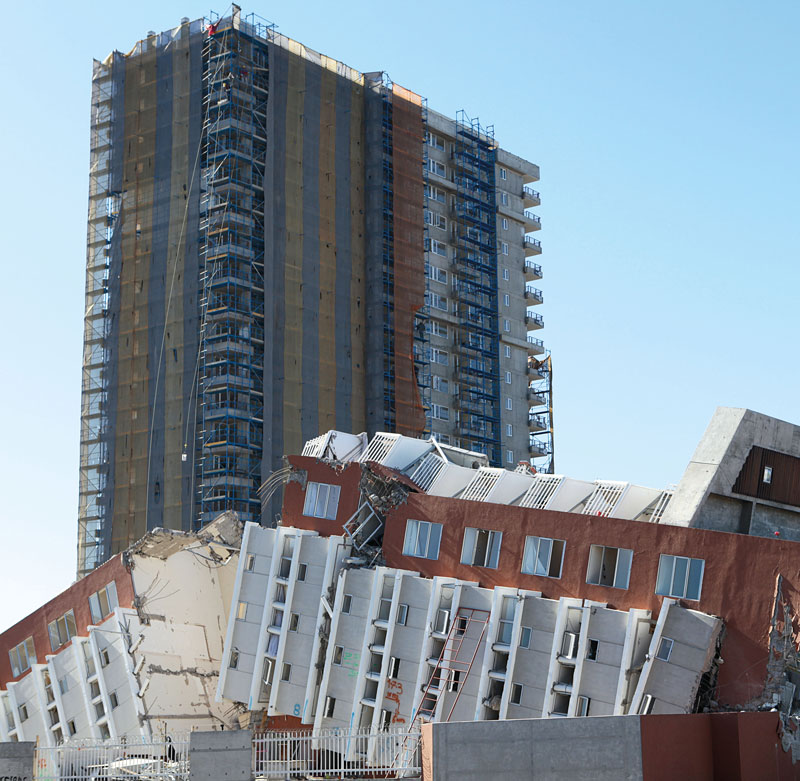 Research teams can perform accurate, large-scale, multidirectional, real-time hybrid simulations (RTHS) that combine physical experiments with computer-based simulations (a form of cyber-physical systems research) for evaluating the performance of systems subjected to natural hazards. This might include studying the effects of soil-foundation structure interaction under wind and earthquake hazards, for example, or, in Harvey’s case, investigating innovative floor-isolation systems.
Research teams can perform accurate, large-scale, multidirectional, real-time hybrid simulations (RTHS) that combine physical experiments with computer-based simulations (a form of cyber-physical systems research) for evaluating the performance of systems subjected to natural hazards. This might include studying the effects of soil-foundation structure interaction under wind and earthquake hazards, for example, or, in Harvey’s case, investigating innovative floor-isolation systems.
Harvey and grad student Braulio Covarrubias Vargas conducted an extensive series of tests using Lehigh’s RTHS capabilities to characterize and evaluate a FIS configured with a rolling pendulum isolation bearing and augmented rolling resistance. The cyber-physical tests measured both FIS-equipment and building-FIS interactions.
Harvey credits Ricles, Sause, Kusko, and other personnel for providing expertise in RTHS that eased the development of the test protocol and expedited the setup time, which allowed for a greater breadth of tests to be conducted.
Ultimately, Harvey says, this research, which builds on years of work on equipment isolation by his group at the University of Oklahoma, will help advance understanding of these devices’ complicated nonlinear dynamics. The data collected at Lehigh will be used to calibrate and validate physics-based mathematical models of the rolling pendulum bearings. He plans to return this summer for the second phase of the project, which will include the development of an experimental testbed for multi-directional RTHS testing of FISs.
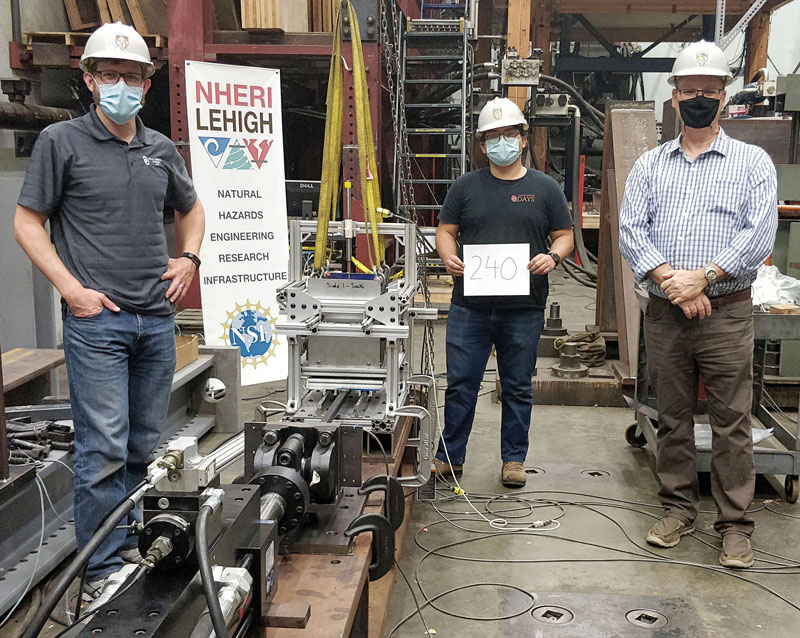 Ricles says that the large-scale real-time experiments performed at the NHERI Lehigh EF will lead to the acquisition of rich data sets and creation of high-fidelity computational models for the purpose of performing advanced numerical simulations. Additionally, the knowledge gained will enable the development of innovative materials and structural concepts.
Ricles says that the large-scale real-time experiments performed at the NHERI Lehigh EF will lead to the acquisition of rich data sets and creation of high-fidelity computational models for the purpose of performing advanced numerical simulations. Additionally, the knowledge gained will enable the development of innovative materials and structural concepts.
The vision for the next five years is clear, Ricles says: “The NHERI Lehigh will continue to foster advances in community natural hazard resilience that will be implemented into engineering practice, as experimental data and related computational models are used to validate new, innovative structural concepts for design and retrofit.”
ADDITIONAL CREDITS: Top photo, John Kish IV; Walter Mooney/U.S. Geological Survey; Easyturn/iStock; Christa Neu/Lehigh University

